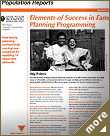|
|
|
Latest Population Reports Issue
 Elements of Success in Family Planning Programming
Elements of Success in Family Planning Programming
What do nearly nearly 500 health care workers from around the world think are the most essential elements of a successful family
planning program? How have programs in Zambia, Guatemala, Colombia, Zimbabwe, Peru, Kenya, and Egypt improved their results?
What more can be done to reduce the percentage of unintended or unplanned pregnancies still estimated at 50%? This 28-page report
is the latest in a series of ongoing efforts to share knowledge from and between family planning program managers and health care
professionals. Co-authors Catherine Richey and Ruwaida Salem synthesize online discussions, summarize survey results, and highlight
program experiences, best practices, and evidence-based guidance.
Download the report. Read the press release.
Contribute to the discussion at www.fpsuccess.org.
|
 Check out INFO's Hot Topics page your one-stop source for cutting-edge, evidence-based health information.
Check out INFO's Hot Topics page your one-stop source for cutting-edge, evidence-based health information.
|
New Global Health Technical Brief Posted
 Decentralization of Postabortion Care in Senegal and Tanzania
Decentralization of Postabortion Care in Senegal and Tanzania
How many women die from abortion-related complications each year? (Hint: These deaths account for 13% of maternal deaths globally.)
According to the latest Global Health Technical Brief prepared by Carolyn Curtis, Public Health Specialist with USAID's Office of
Global Health, between 10 and 50 percent of women who undergo abortions need medical care for life. The two-page Brief discusses
how programs in Sengal and Tanzania expanded access to post abortion care by decentralizing services. Find out what the evaluation
of the programs revealed with regard to costs, training, provider bias, access, referral procedures, contraceptive use, and more.
|
|





